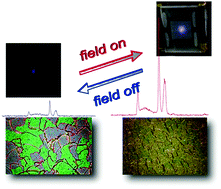Electrically enhancing and modulating the photoluminescence of upconversion nanoparticles using liquid crystals
Abstract
The use of an external electric field to enhance and modulate the photoluminescence (PL) of lanthanide-doped upconversion nanoparticles (UCNPs) is challenging. A liquid crystal (LC)-based approach is demonstrated in this study. By loading UCNPs in a polymer-stabilized, homogeneous LC matrix, the upconversion PL intensity can increase or decrease almost linearly upon increase or decrease, respectively, of the applied voltage, reaching an enhancement factor of about 6–8 at an electric field of 4.6 V μm−1 depending on the 980 nm excitation laser power and the applied a.c. field frequency. The origin of the electrical enhancement and modulation is the electric field induced LC texture (orientation state) transition that controls the light scattering of the LC/UCNP mixture. Increased scattering of the near infrared (NIR) excitation light before exciting the material increases its probability to be absorbed by the UCNPs and thus leads to enhanced PL emission. This LC scattering-based approach is facile, versatile and can readily be applied to UCNPs with no need for chemical composition or structural modifications that often require tedious synthesis.



 Please wait while we load your content...
Please wait while we load your content...